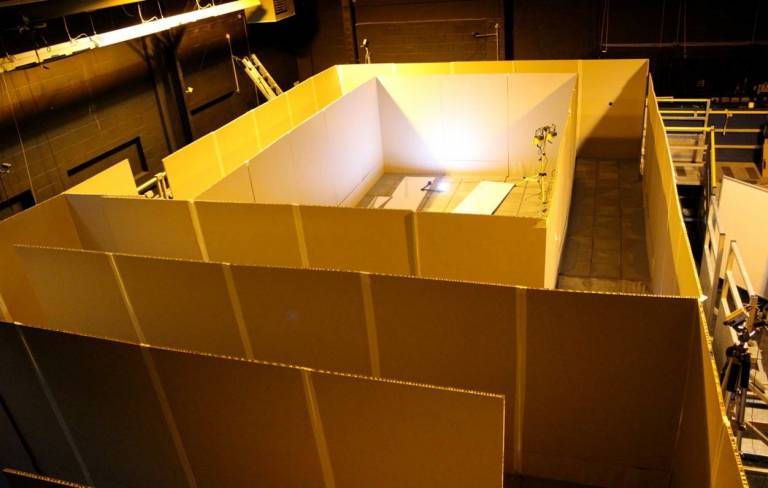PEARL (Person-Environment-Activity Research Laboratory) is a unique facility designed to explore the ways in which people interact with their environment.
Vision
PEARL's vision is simple - to create a world where everyone can achieve a better quality of life. This involves viewing cities not as buildings or infrastructure, but as people.
About
PEARL (Person-Environment-Activity Research Laboratory) will be a unique facility that will explore the ways in which people interact with their environment. Due to open in the early 2020s, with a site earmarked in east London, PEARL will provide the wherewithal for researchers to engage with the public to discover what activities people want or need to do, and the ways in which the environment helps or hinders them. From this knowledge we will then be able to apply and test the ways in which we can design the environment to enable people to live with a greater quality of life in the social space that is society.
At around 4,000m squared, and 10m high, PEARL will be massive, dwarfing its sister facility, PAMELA. Such a research and experimental space can create life-sized, controlled condition environments - e.g. a railway station, a high street or town square – where people's interaction with the environment and each other can be examined. We will change the profile, type and material of the floor, simulate lighting of any hue and intensity, create sound from the tiniest bird song to the most massive explosion, include olfactory sensations and much more.

UCL Pedestrian Accessibility Movement Environment Laboratory (PAMELA) in a maze configuration. PEARL will be provide similar research opportunities and possibilities to PAMELA, but on a much larger scale.
PEARL will allow us to study interactions at a micro-scale, such as brain activity, skin response, mass-distribution in the foot, or emotional responses. The physical displacements of people in response to environmental design (what they see, touch, hear, smell or feel) or to dynamic conditions (such as explosions, instructions or exogenous movements) will also be studied.
In turn, this will allow us to study the effects of design on people – capacity, flow, behavioural responses – or the effectiveness of therapies (e.g. remediation of locomotory, eye or hearing conditions) in the course of a person’s daily lived activities, and to research in detail the impacts of the environment on stress, contentment, fear, safety, and other perceptions, (e.g. fairness, culture, inclusion, or navigation). In addition it allows us to study the effects of performing and other arts on the way we can think about the design of the environment, in terms of the opportunities they afford and the responses they might encourage from the public, environment managers, transport systems operators, or police and security services.
PEARL will allow the public, researchers in many disciplines, regulators, implementers and others to see what operation and design ideas would look, feel and work like, thereby cutting the cost of trying out new ideas by testing them in the laboratory before trialling them for real on-street.
People
Research
Engineering makes things happen, and PEARL is an example of how we can study just what effect civil, environmental, transport, fire, vehicle and control engineering, operations and security management can have on people’s ability to live a quality life. Results of work in PAMELA can be seen in railway systems in London and beyond, and more is being requested in the future, for new trains and operating systems.
The following UCL Faculties have expressed an interest in using PEARL for their own research purposes:
- Arts & Humanities
- Social & Historical Sciences
- Laws
- Institute of Education
- Brain Sciences
- Medical Sciences
- Population Health Sciences
- MAPS
- Built Environment
The UK Collaboratorium for Research on Infrastructure and Cities (UKCRIC) is the basis for the UK Government’s investment in PEARL. UKCRIC is a set of new laboratories currently spread amongst 14 universities in the UK, designed to enable innovative research to drive the investment of £600bn in infrastructure in the UK over the next 50 years.
PEARL will be the UCL element of the UKCRIC facility. UKCRIC represents the Government’s – and Research Councils’ – support for research in infrastructure in and between cities. PEARL will be the only UKCRIC facility that involves multiscalar analysis of people and their interactions with infrastructure and city environments. It thus lies at the heart of the UKCRIC philosophy and implementation.
Teaching
PEARL offers a great opportunity to revise how we teach Master's programmes in relation to the urban environment, taking advantage of the facilities available in the laboratory. Such programmes will be highly transdisciplinary, including a common theme of urban engineering as the core element, which will be complemented by a component related to different disciplines.
 Close
Close

